博文
Phenomics | Phenomics期刊2023年第四期文章合集
|
本文介绍了Phenomics期刊2023年第四期收录文章合集,文章概览如下,请查收!

(Phenomics期刊2023年第四期封面图)
01 High Arterial Oxygen Saturation in the Acclimatized Lowlanders Living at High Altitude
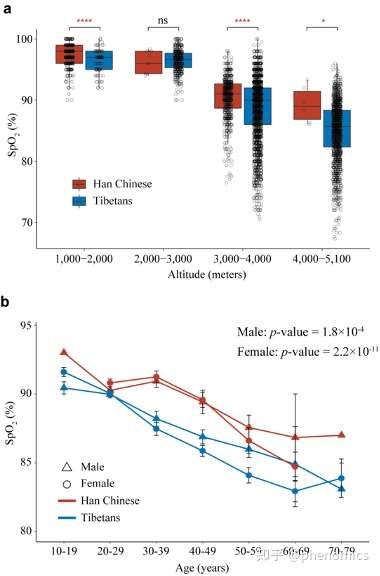
不同海拔藏族和汉族的SpO2水平比较
DOI:https://link.springer.com/article/10.1007/s43657-023-00117-x
引用格式:He, Y., Cui, C., Guo, Y. et al. High Arterial Oxygen Saturation in the Acclimatized Lowlanders Living at High Altitude. Phenomics 3, 329–332 (2023). https://doi.org/10.1007/s43657-023-00117-x
血氧饱和度(SpO2)是评估体内可用氧的关键指标。高海拔地区低SpO2与生理性低氧血症引起的发病率和死亡率风险相关。该研究中,研究人员比较了生活在海拔1120~5020米的5929名藏族人和1034名汉族人的SpO2。研究结果发现与以往的普遍认知不同,生活在高海拔地区的平原人群反而表现出比高原世居人群更高的SpO2水平,且该模式与较高的高原慢性病发病率相关。
AbstractBlood oxygen saturation (SpO2) is a key indicator of oxygen availability in the body. It is known that a low SpO2 at high altitude is associated with morbidity and mortality risks due to physiological hypoxemia. Previously, it was proposed that the lowlander immigrants living at high altitude should have a lower SpO2 level compared to the highlander natives, but this proposal has not been rigorously tested due to the lack of data from the lowlander immigrants living at high altitude. In this study, we compared arterial oxygen saturation of 5929 Tibetan natives and 1034 Han Chinese immigrants living at altitudes ranging from 1120 m to 5020 m. Unexpectedly, the Han immigrants had a higher SpO2 than the Tibetan natives at the same high altitudes. At the same time, there is a higher prevalence of chronic mountain sickness in Han than in Tibetans at the same altitude. This result suggests that the relatively higher SpO2 level of the acclimatized Han is associated with a physiological cost, and the SpO2 level of Tibetans tends to be sub-optimal. Consequently, SpO2 alone is not a robust indicator of physiological performance at high altitude.
02 Integrative Identification by Hi-C Revealed Distinct Advanced Structural Variations in Lung Adenocarcinoma
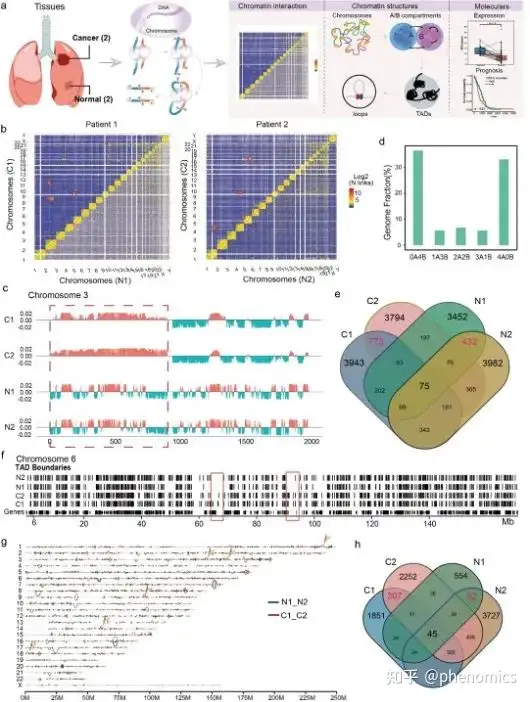
两种LUAD和正常组织三维基因组的全局特征
DOI:https://link.springer.com/article/10.1007/s43657-023-00103-3引用格式:Song, T., Yao, M., Yang, Y. et al. Integrative Identification by Hi-C Revealed Distinct Advanced Structural Variations in Lung Adenocarcinoma Tissue. Phenomics 3, 390–407 (2023). https://doi.org/10.1007/s43657-023-00103-3
本研究中,研究者对两对非吸烟肺癌(LUAD)患者的肿瘤和邻近正常组织进行了Hi-C测序,进一步分析肿瘤组织和正常组织间的A/B区室、TADs和染色质环的差异,确定了肿瘤特异性的A/B间隔、TADs和染色质环。结果表明,LUAD的染色质结构变异主要来自Chr3,且发现了5个重要的与肿瘤进展相关的基因(SYT16、NCEH1、NXPE3、MB21D2、DZIP1L)。
AbstractAdvanced three-dimensional structure variations of chromatin in large genome fragments, such as conversion of A/B compartment, topologically associated domains (TADs) and chromatin loops are related closely to occurrence of malignant tumors. However, the structural characteristics of lung cancer still remain uncovered. In this study, we used high-throughput chromosome (Hi-C) conformation capture technology to detect the advanced structural variations in chromatin of two non-smoking lung adenocarcinoma (LUAD) tumor and paired normal tissues. The results indicate that significant chromatin variations are detected in tumor tissues compared with normal tissues. At compartment scale, the main conversion type of compartment is A → B in tumor tissues, which are concentrated mainly on chromosome 3 (Chr3) (33.6%). A total of 216 tumor-specific TADs are identified in tumor tissues, which are distributed mainly in Chr1 (19), Chr2 (15) and Chr3 (17). Forty-one distinct enhancer-promoter loops are observed in tumor tissue, which are associated closely to tumor-related pathways including mitogen-activated protein kinase (MAPK), Phosphatidylinositol-3-kinase-Protein kinase B (PI3K-AKT), Ras, Wnt and Ras1. The most important observation in this study is that we identify five important genes (SYT16, NCEH1, NXPE3, MB21D2, and DZIP1L), which are detected in both A → B compartment, TADs and chromatin loops in tumor samples, and four of these genes (NCEH1, NXPE3, MB21D2, and DZIP1L) locate on q arm of Chr3. Further gene expression and invasion experiment analysis show that NCEH1, MB21D2 and SYT16 are involved in the tumor development. Thus, we provide a comprehensive overview of advanced structures in LUAD for the first time and provide a basis for further research on the genetic variation of this tumor.
03 Overview of a Sleep Monitoring Protocol for a Large Natural Population

睡眠表型采集流程
DOI:https://doi.org/10.1007/s43657-023-00102-4
引用格式:Liu, M., Zhu, H., Tang, J. et al. Overview of a Sleep Monitoring Protocol for a Large Natural Population. Phenomics (2023). https://doi.org/10.1007/s43657-023-00102-4
本实验手册提出了一种用于大型人群队列研究的睡眠表型标准操作程序,提供了标准化的睡眠访谈、睡眠相关问卷、实验室多导睡眠图(Polysomnography, PSG)睡眠监测的流程,并全面概述了睡眠数据分析、表型提取、数据存储的方法。本文旨在提出规范化、标准化与普适化的睡眠表型采集流程,提高科研效率,减少大型人群队列研究的不必要工作量,为科研人员进行系统的睡眠研究提供有价值的参考。
AbstractA standard operating procedure for studying the sleep phenotypes in a large population cohort is proposed. It is intended for academic researchers in investigating the sleep phenotypes in conjunction with the clinical sleep disorders assessment guidelines. The protocol refers to the definitive American Academy of Sleep Medicine (AASM) manual for setting polysomnography (PSG) technical specifications, scoring of sleep and associated events, etc. On this basis, it not only provides a standardized procedure of sleep interview, sleep-relevant questionnaires, and laboratory-based PSG test, but also offers a comprehensive process of sleep data analysis, phenotype extraction, and data storage. Both the objective sleep data recorded by PSG test and subjective sleep information obtained by the sleep interview and sleep questionnaires are involved in the data acquisition procedure. Subsequently, sleep phenotypes can be characterized by observable/inconspicuous physiological patterns during sleep from PSG test or can be marked by sleeping habits like sleep quality, sleep latency, sleep duration, habitual sleep efficiency, sleep disturbances, daytime dysfunction, etc., from sleep interview or questionnaires derived. In addition, solutions to the problems that may be encountered during the protocol are summarized and addressed. With the protocol, it can significantly improve scientific research efficiency and reduce unnecessary workload in large population cohort studies. Moreover, it is also expected to provide a valuable reference for researchers to conduct systematic sleep research.
04 DBLiPro: A Database for Lipids and Proteins in Human Lipid Metabolism
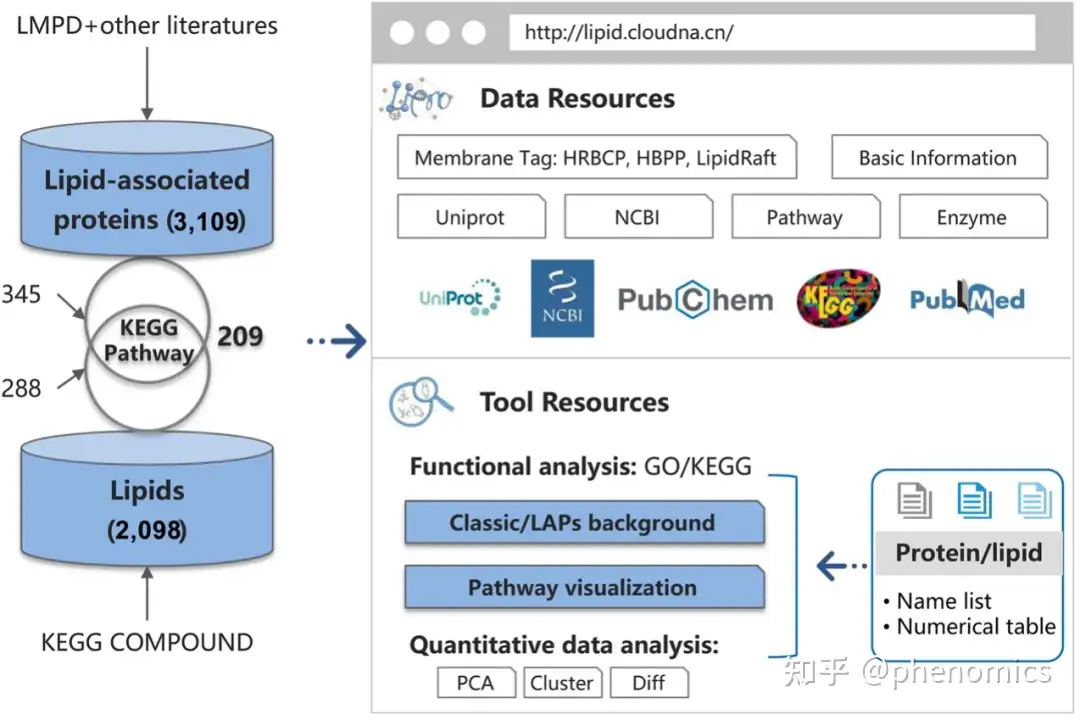
DBLiPro的总体概略图
DOI:https://link.springer.com/article/10.1007/s43657-023-00099-w
引用格式:Wu, Q., Huang, Y., Kong, X. et al. DBLiPro: A Database for Lipids and Proteins in Human Lipid Metabolism. Phenomics (2023). https://doi.org/10.1007/s43657-023-00099-w
本文展示了研究团队合作开发的人类脂代谢相关蛋白和脂类数据资源平台DBLiPro,包括有多种实用标签的系统的脂代谢相关脂质和蛋白知识库以及用户友好的多组学分析工具。DBLiPro可以帮助生物、医学、化学和材料学研究人员,便捷地开展人类脂质代谢相关数据分析和研究,特别是转录组、蛋白质组和脂质组的整合挖掘。
AbstractTo help researchers in the field of biology, medicine, chemistry, and materials science to use lipidomic data conveniently, there is an urgent need to develop a platform that provides a systematic knowledgebase of human lipid metabolism and lipidome-centric omics analysis tools. DBLiPro is a user-friendly webserver allowing for access to human metabolism-related lipids and proteins knowledge database and an interactive bioinformatics integrative analysis workflow for lipidomics, transcriptomics, and proteomics data. In DBLiPro, there are 3109 lipid-associated proteins (LAPs) and 2098 lipid metabolites in the knowledge base section, which were obtained from Uniprot, Kyoto Encyclopedia of Genes and Genomes (KEGG) and were further annotated by information from other public resources in the knowledge base section, such as RaftProt and PubChem. DBLiPro offers a step-by-step interactive analysis workflow for lipidomics, transcriptomics, proteomics, and their integrating multi-omics analysis focusing on the human lipid metabolism. In summary, DBLiPro is capable of helping users discover key molecules (lipids and proteins) in human lipid metabolism and investigate lipid–protein functions underlying mechanisms based on their own omics data. The DBLiPro is freely available at http://lipid.cloudna.cn/home.
05 Virtual Fluorescence Translation for Biological Tissue by Conditional Generative Adversarial Network
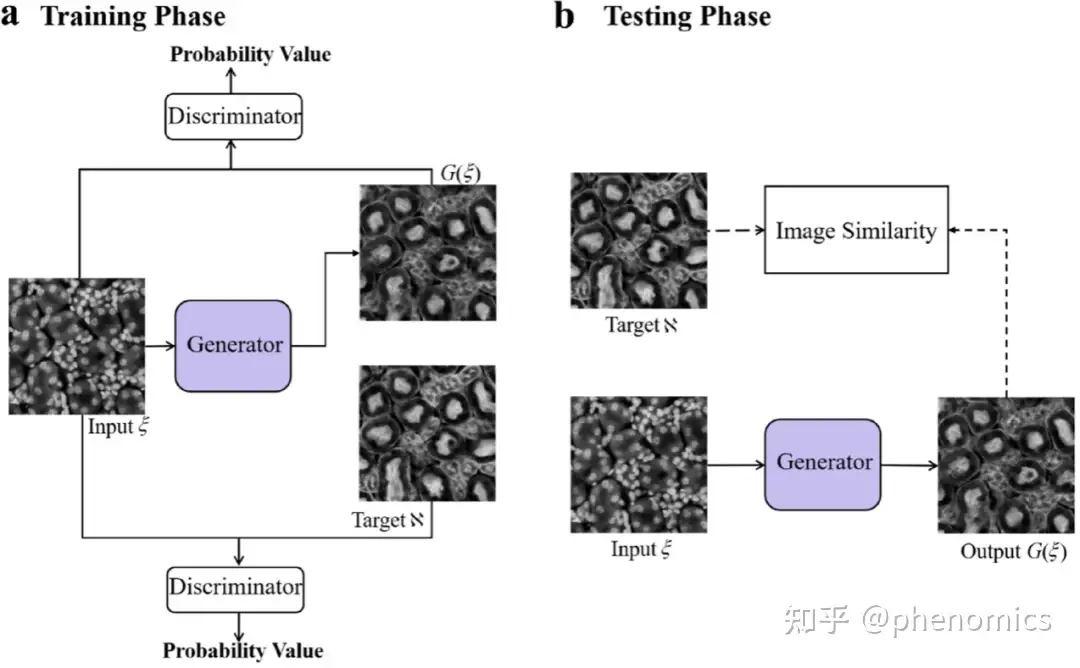
基于 cGAN 的组织切片荧光翻译方法框架
DOI:https://doi.org/10.1007/s43657-023-00094-1
引用格式:Liu, X., Li, B., Liu, C. et al. Virtual Fluorescence Translation for Biological Tissue by Conditional Generative Adversarial Network. Phenomics 3, 408–420 (2023). https://doi.org/10.1007/s43657-023-00094-1
荧光标记和成像是观察生物组织结构的重要手段,在组织病理学领域发挥着至关重要的作用。然而,在对生物组织进行标记和成像时,仍然存在一些挑战,例如耗时的组织制备步骤、昂贵的试剂以及光漂白导致的信号偏差。为了克服这些限制,本研究提出了一种基于生成对抗网络的生物组织荧光标记方法,该方法由条件生成对抗网络(cGAN)实现。小鼠肾脏组织的实验结果表明,该方法可以从一张原始荧光图像预测其他类型的荧光图像,并通过合并生成的不同荧光图像实现虚拟多标签荧光染色。此外,该方法还能有效减少成像过程中费时费力的准备工作,进一步节约成本和时间。
AbstractFluorescence labeling and imaging provide an opportunity to observe the structure of biological tissues, playing a crucial role in the field of histopathology. However, when labeling and imaging biological tissues, there are still some challenges, e.g., time-consuming tissue preparation steps, expensive reagents, and signal bias due to photobleaching. To overcome these limitations, we present a deep-learning-based method for fluorescence translation of tissue sections, which is achieved by conditional generative adversarial network (cGAN). Experimental results from mouse kidney tissues demonstrate that the proposed method can predict the other types of fluorescence images from one raw fluorescence image, and implement the virtual multi-label fluorescent staining by merging the generated different fluorescence images as well. Moreover, this proposed method can also effectively reduce the time-consuming and laborious preparation in imaging processes, and further saves the cost and time
06 International Nuclear Medicine Consensus on the Clinical Use of Amyloid Positron Emission Tomography in Alzheimer’s Disease
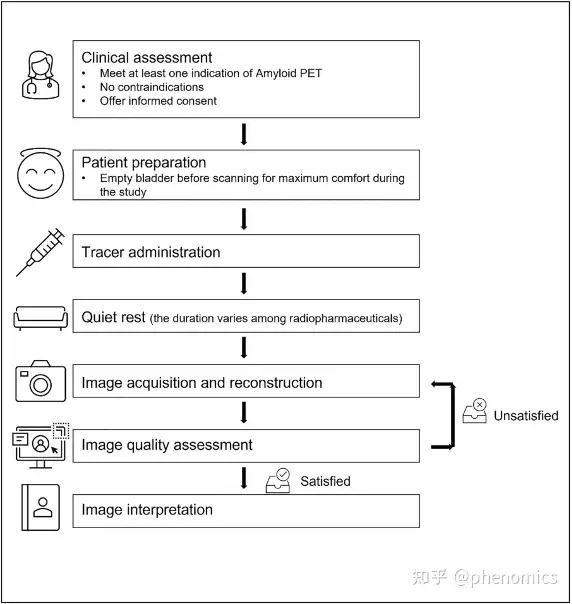
淀粉样蛋白PET扫描的工作流程
DOI:https://doi.org/10.1007/s43657-022-00068-9
引用格式:Tian, M., Zuo, C., Civelek, A.C. et al. International Nuclear Medicine Consensus on the Clinical Use of Amyloid Positron Emission Tomography in Alzheimer’s Disease. Phenomics 3, 375–389 (2023). https://doi.org/10.1007/s43657-022-00068-9
本共识由我国科学家田梅、左传涛、张宏等人牵头国际相关领域专家及国际学术组织,全面梳理了淀粉样蛋白PET分子影像检查在AD患者诊疗应用中的新发现、新进展,重点关注临床指征,患者准备,分子影像探针合成,图像采集、处理、解读和报告,整合国际知名研究机构的专家意见建议,更新完成了最新临床共识;这将进一步促进淀粉样蛋白PET分子影像检查在AD患者临床诊疗中的规范化应用。
AbstractAlzheimer’s disease (AD) is the main cause of dementia, with its diagnosis and management remaining challenging. Amyloid positron emission tomography (PET) has become increasingly important in medical practice for patients with AD. To integrate and update previous guidelines in the field, a task group of experts of several disciplines from multiple countries was assembled, and they revised and approved the content related to the application of amyloid PET in the medical settings of cognitively impaired individuals, focusing on clinical scenarios, patient preparation, administered activities, as well as image acquisition, processing, interpretation and reporting. In addition, expert opinions, practices, and protocols of prominent research institutions performing research on amyloid PET of dementia are integrated. With the increasing availability of amyloid PET imaging, a complete and standard pipeline for the entire examination process is essential for clinical practice. This international consensus and practice guideline will help to promote proper clinical use of amyloid PET imaging in patients with AD.
07 Immune-Ageing Evaluation of Peripheral T and NK Lymphocyte Subsets in Chinese Healthy Adults

36个免疫细胞亚型在健康人衰老过程中的动态变化情况
DOI:https://doi.org/10.1007/s43657-023-00106-0
引用格式:Jia, Z., Ren, Z., Ye, D. et al. Immune-Ageing Evaluation of Peripheral T and NK Lymphocyte Subsets in Chinese Healthy Adults. Phenomics (2023). https://doi.org/10.1007/s43657-023-00106-0
本研究首次报道了在大样本中国人群中不同年龄段人群的T细胞、NK细胞功能状态,及细胞百分比参考区间, 同时通过免疫大数据成果建立了我国首个“免疫年龄”计算模型,并揭示了中国健康成年人T细胞及NK细胞随年龄而变化的趋势。
AbstractAgeing is often accompanied with a decline in immune system function, resulting in immune ageing. Numerous studies have focussed on the changes in different lymphocyte subsets in diseases and immunosenescence. The change in immune phenotype is a key indication of the diseased or healthy status. However, the changes in lymphocyte number and phenotype brought about by ageing have not been comprehensively analysed. Here, we analysed T and natural killer (NK) cell subsets, the phenotype and cell differentiation states in 43,096 healthy individuals, aged 20–88 years, without known diseases. Thirty-six immune parameters were analysed and the reference ranges of these subsets were established in different age groups divided into 5-year intervals. The data were subjected to random forest machine learning for immune-ageing modelling and confirmed using the neural network analysis. Our initial analysis and machine modelling prediction showed that naïve T cells decreased with ageing, whereas central memory T cells (Tcm) and effector memory T cells (Tem) increased cluster of differentiation (CD) 28-associated T cells. This is the largest study to investigate the correlation between age and immune cell function in a Chinese population, and provides insightful differences, suggesting that healthy adults might be considerably influenced by age and sex. The age of a person's immune system might be different from their chronological age. Our immune-ageing modelling study is one of the largest studies to provide insights into ‘immune-age’ rather than ‘biological-age’. Through machine learning, we identified immune factors influencing the most through ageing and built a model for immune-ageing prediction. Our research not only reveals the impact of age on immune parameter differences within the Chinese population, but also provides new insights for monitoring and preventing some diseases in clinical practice.
08 Genetic Phenotypes of Alzheimer’s Disease: Mechanisms and Potential Therapy
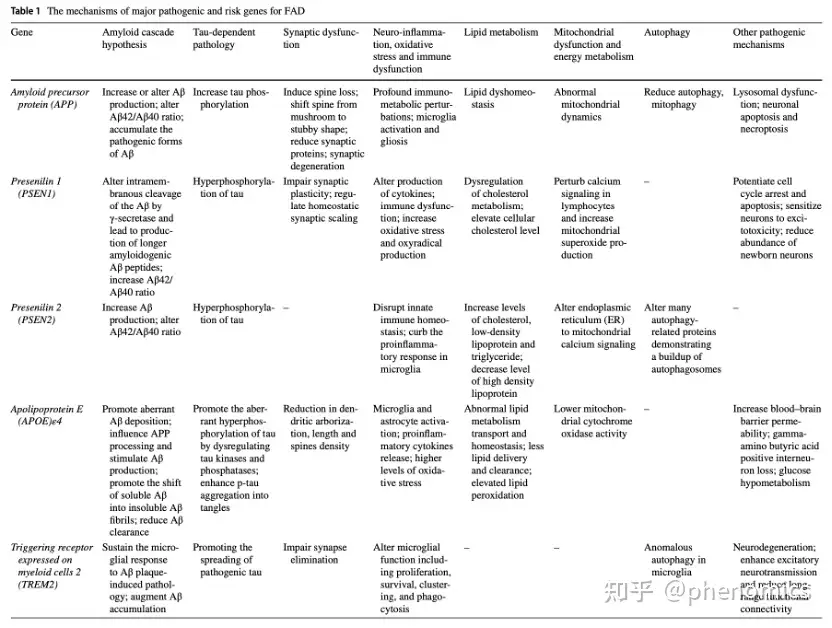
FAD 的主要致病基因和风险基因的作用机制
DOI:https://doi.org/10.1007/s43657-023-00098-x引用格式:Quan, M., Cao, S., Wang, Q. et al. Genetic Phenotypes of Alzheimer’s Disease: Mechanisms and Potential Therapy. Phenomics (2023). https://doi.org/10.1007/s43657-023-00098-x
本研究探讨了阿尔茨海默病(AD)遗传和分子研究的最新进展,有助于理解家族性AD的遗传表型,并将其与散发性AD进行比较,还进一步回顾了AD基因治疗的进展,并基于遗传表型讨论了未来的应用前景。
AbstractYears of intensive research has brought us extensive knowledge on the genetic and molecular factors involved in Alzheimer's disease (AD). In addition to the mutations in the three main causative genes of familial AD (FAD) including presenilins and amyloid precursor protein genes, studies have identified several genes as the most plausible genes for the onset and progression of FAD, such as triggering receptor expressed on myeloid cells 2, sortilin-related receptor 1, and adenosine triphosphate-binding cassette transporter subfamily A member 7. The apolipoprotein E ε4 allele is reported to be the strongest genetic risk factor for sporadic AD (SAD), and it also plays an important role in FAD. Here, we reviewed recent developments in genetic and molecular studies that contributed to the understanding of the genetic phenotypes of FAD and compared them with SAD. We further reviewed the advancements in AD gene therapy and discussed the future perspectives based on the genetic phenotypes.
欢迎投稿我们诚挚地邀请广大科研人员投稿!Phenomics官网:https://www.springer.com/journal/43657投稿链接:https://www.editorialmanager.com/pnmc/编辑部邮箱:phenomics@ihup.org.cn、phenomics@fudan.edu.cn
Phenomics期刊简介
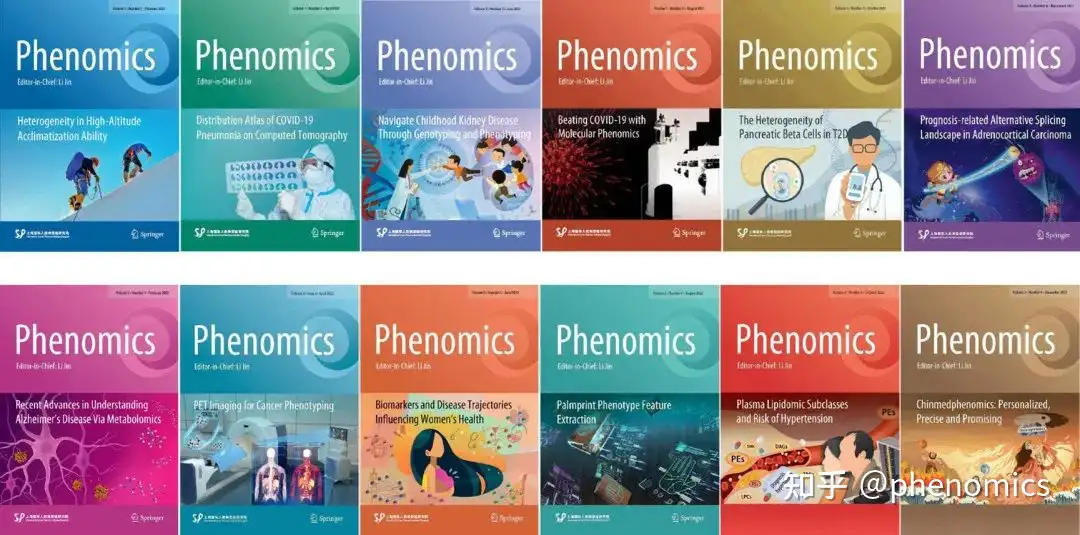
Phenomics是一本新创的同行评审国际期刊,聚焦表型组学前沿研究,搭建全球表型组学领域专家交流的国际平台,推动该领域相关的理论创新和学科发展。
本期刊拥有强大的国际编委团队,复旦大学金力院士担任主编,美国系统生物学研究所Leroy Hood院士、澳大利亚莫道克大学Jeremy Nicholson院士、德国莱布尼兹环境医学研究所Jean Krutmann院士、复旦大学唐惠儒教授共同担任副主编,复旦大学丁琛教授担任执行主编,另有来自全球多国的三十多位著名科学家共同组成编委团队,以及四十多位青年科学家组成青年编委团队。
我们诚挚地邀请广大科研人员投稿!
Phenomics官网:https://www.springer.com/journal/43657
投稿链接:https://www.editorialmanager.com/pnmc/
编辑部邮箱:phenomics@ihup.org.cn、phenomics@fudan.edu.cn
欢迎关注Phenomics官方公众号

文章来源:人类表型组计划公众号
https://blog.sciencenet.cn/blog-3558836-1426415.html
上一篇:Phenomics | Phenomics期刊2023年第五期文章合集
下一篇:《人类表型组研究进展报告2022》全文正式发布
全部作者的其他最新博文
- • Phenomics | 山东大学陈子江院士/赵世刚教授团队通过孟德尔随机化研究发现多囊卵巢综合征和胰腺癌无直接因果关系
- • 《表型组学》 复旦吴俊杰、宋元林,南医大沈波,长海医院黎正行揭示MBD4基因rs140693多态性显著影响肺癌患者预后
- • Phenomics | 中国中医科学院仝小林院士团队发表“基于糖尿病探讨中医药表型组学研究”综述
- • Phenomics | 表型组学期刊发展研讨会成功举办
- • Phenomics | 复旦大学生命科学学院洪尚宇研究员团队发现饲养环境通过调节肠道菌群改变小鼠生酮饮食诱导的代谢变化
- • 《表型组学》川大杨浩、戴伦治,中国科学院杨刚龙,北大吕继成教授共同评述糖基化定量方法GlycoQuant的临床运用潜力